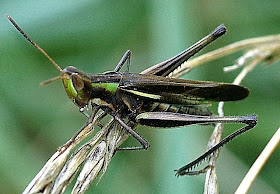 |
| Panther-spotted Grasshopper (Poecilotettix pantherinus) subsp. santaclausi |
 |
| Trimerotropis cyaneipennis |
Many Bandwing Grasshoppers are very cryptic while they are sitting quietly. When they fly up, many flash colorful hindwings. This certainly is used as a mating display, but I am sure it also causes a startling response in many predators. Of course it is very difficult to photograph this and I am showing a pinned specimen instead. Those underwing colors are usually part of the species description so it is useful to note them down with your observations, even if you can't get a photo
 |
| Our 3 Arizona species of Insara: Insara covilleae on Creosote, Insara on Mesquite, Insara tesselata on Juniper |
 |
| Bootettix argentatus (Creosote Bush Grasshopper) |
Its range is basically the same as Creosote Bush (Larrea) in North America from western Texas and New Mexico to California, and southward. A vegetarian that CAN digest all the toxic ingredients of Creosote might as well be completely specialized on it.
 |
| Prorocorypha snowi (Snow's toothpick grasshopper) Montosa Canyon, Santa Cruz County |
.jpg) |
| Paratettix aztecus (Aztec Pygmy Grasshopper) Sabino Canyon |
 |
| Paratettix mexicanus, Marana |
 |
| Syrbula montezuma (Montezuma's Grasshopper), male |
 |
| Syrbula montezuma (Montezuma's Grasshopper),female |
Garden Canyon, Huachuca Mt, Cochise Co, AZ
a species of Slantface Grasshopper,
Southwestern United States: Arizona east to Texas, north to Colorado, and south through much of Mexico. Areas of tall grass in arid grasslands
 |
| Melanoplus thomasi (Thomas's Two-striped Grasshopper) |
M. thomasi can be abundant in late autumn in relatively moist, lush, weedy meadows. Wide spread: Coast to coast across southern Canada and most of the US except Florida, south Atlantic and Gulf coastal plain, and southwestern arid regions. Perhaps into northernmost Sonora and Chihuahua, Mexico.
Melanoplus thomasi in the southwest is usually bright blue-green with brilliant red on inner hind femur and brilliant red hind tibiae. Other populations just yellowish and brown (sometimes greenish or blackish) but always with two distinct pale yellowish stripes along sides of top
 |
| Capnobotes fuliginosus (Sooty Longwing) |
 |
| Capnobotes fuliginosus (Sooty Longwing) nymph |
Florida Canyon. Santa Rita Mts, Santa Cruz Co, AZ, USA
This is a very big katydid that is more carnivorous than other Orthopterans in AZ. While most of them will add protein to their diet when they can, these big guys are active nightly hunters as even the nymph on the right proves. The adults can bite defensively too and, when threatened, do an impressive startle display with their big dark hind-wings.
 |
| Stilpnochlora, azteca or S. thoracica Piotr Naskrecki det. |
 |
| Arethaea gracilipes Thread-legged Katydid |
Here is another orthopteran superbly adapted to living in the thin summer grasses. Hiding in plain sight. I have better macro shots, but I like this one because it shows the insect in its 'element'
 |
| Gryllus personatus, Badlands Cricket |
Picture Rocks
Pima Co, AZ, USA
Dave Ferguson on BugGuide: One of few species usually easily recognized
by coloration and pattern. It has a distinctive pattern of dark on tan
that varies a bit, but is always basically the same. Individuals may be
long-winged or short-winged. They often come to lights, particularly
long-winged individuals which can fly. Adults will shed hind wings (not
tegmina) when molested, and thus long-winged individuals may become
non-winged individuals
The song is a typical Cricket-like chirping, but the frequency and rate of beats make it sound less musical and a bit more "metallic" than most other species of Gryllus.
Habitat :
Mostly open clay, silt, or calcareus areas with light-colored dusty soil. Mostly in desert and dry grassland. Often in "badland" type areas on the Great Plains. They tend to be most often seen living in cracks in the gound, and pouring water into the cracks where you hear them singing is often the easiest way to find them; they often rush out of the cracks.
Season:
Adults are usually seen late spring through summer. Earlier in the south than in the north. Late specimens indicate that there may be a second brood in some regions..
The song is a typical Cricket-like chirping, but the frequency and rate of beats make it sound less musical and a bit more "metallic" than most other species of Gryllus.
Habitat :
Mostly open clay, silt, or calcareus areas with light-colored dusty soil. Mostly in desert and dry grassland. Often in "badland" type areas on the Great Plains. They tend to be most often seen living in cracks in the gound, and pouring water into the cracks where you hear them singing is often the easiest way to find them; they often rush out of the cracks.
Season:
Adults are usually seen late spring through summer. Earlier in the south than in the north. Late specimens indicate that there may be a second brood in some regions..
 |
| Pristoceuthophilus arizonae Ted Cohn det., a Camel Cricket from Mt. Graham, AZ |
Many Orthopterans use songs to claim territories and attract mates. Some are still active at this time of the year. Here is the Christmas song of a Tree Cricket at the Santa Cruz River in Marana
 |
| Swaison's Hawks over the grasshopper meadows of Sulfur Springs Valley. Photo Lois Manowitz |
Orthoptera are probably one of the most successful groups of animals in the wide grasslands of Southern Arizona, at least considering the biomass that they produce. So it is not surprising that many reptiles, mammals and birds rely on the abundant supply of nutritious prey. Especially impressive are the huge congregations of migrating birds of prey that can be seen feasting in Sulfur Springs Valley in Autumn.

No comments:
Post a Comment